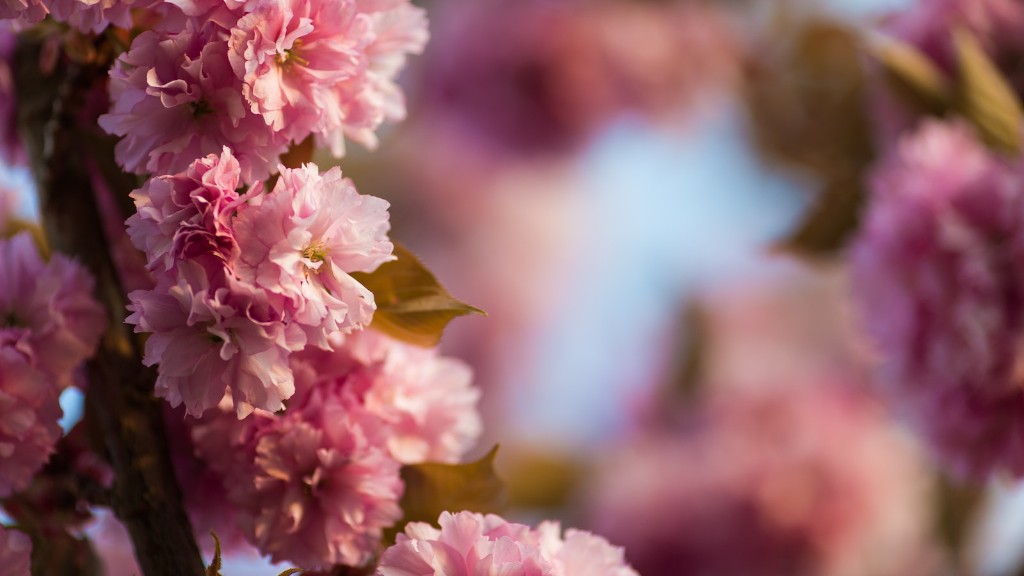Overview
Cherry tree leaf scorch is a process in which the leaves of a cherry tree yellow and wilt, eventually leading to leaf drop. Although it can be a beautiful sight to behold in autumn, it’s a sign that the tree is not doing well and requires some attention. This article will outline how this condition can be prevented, what to do in the event that it is already noticeable and how best to restore the tree to full health.
Causes
Cherry tree leaf scorch is usually caused by any combination of a variety of problems, but mostly by environmental conditions; too much sunlight, a lack of water, an imbalance of nutrients, and/or insect infestations all play a part in promoting leaf scorch. During periods of prolonged drought or extreme heat, cherry trees can be especially prone to leaf scorch.
Signs
One of the first signs of cherry tree leaf scorch can be seen in the leaves. Pale or yellow spots may appear on the edges or veins of the leaves, followed by wilting and curling. These spots might also be accompanied by small discolored patches that appear on the undersides of the leaves. Twig dieback and discolored bark may also be visible.
Prevention
The first step to preventing leaf scorch is to ensure that your cherry tree has the right environment. Plant your tree in a spot with adequate sunlight, water it as needed, and make sure it has access to a good drainage system. Additionally, to keep the tree healthy, it’s important to know when to prune and how to recognize any signs of disease. Overall, a healthy and well-maintained tree is less likely to experience leaf scorch.
Treatment
If your tree is already showing signs of leaf scorch, then the first step is to try to determine the underlying cause. If the weather is particularly hot and dry, you might consider providing supplemental water and adding mulch around the tree to conserve moisture. If it appears that the tree is suffering from a nutrient imbalance, then an appropriate fertilizer can be used. If the tree has signs of insect infestation, then call a qualified arborist for advice.
Once the appropriate measures have been taken to eliminate the underlying cause of the leaf scorch, it will be necessary to prune away the affected branches to make room for new growth. The tree should be fertilized in the spring, and a fungicide may also be beneficial in order to protect against further damage.
Environment && Soil Conditions
Cherry trees need a soil that is well-draining and slightly acidic. Additionally, they also need to be planted in a spot that gets full sun. Although some trees can tolerate partial shade, they tend to be less disease resistant when planted in a shady spot. Also, ensure that your tree has the right conditions throughout the growing season, as environmental stress can cause the tree to become more likely to succumb to leaf scorch.
Fertilizer
Plants need a steady provide of well-balanced nutrients to stay healthy, and cherry trees are no different. It’s important to monitor the needs of your tree and apply a fertilizer when needed. A fertilizer specifically made for cherries is best, as these fertilizers are formulated for their special needs. Also, make sure to apply the fertilizer in the spring, as this is when the tree needs it the most.
Insect Infestations
Cherry trees can be victims of any number of leaf-eating pests, and this can significantly increase the chances of leaf scorch. Monitor your tree regularly to ensure that it is free of insects, and always look for signs of infestation such as small holes in the leaves or sap oozing out of the branches. If you do find signs of an infestation, contact a qualified arborist to identify the exact cause and provide appropriate treatment.
Pruning
To encourage healthy new growth in your cherry tree, you may need to prune away affected branches. This should be done in the winter or early spring, before the sap begins to flow. Pruning back weak or diseased branches will help the tree to focus its energy and nutrients on healthy, new growth. Additionally, it can also help encourage the tree to spread out in order to reach for sunlight and improve air circulation.
Pest Control
In order to protect your cherry tree against insect infestations and other pests that can increase the chances of leaf scorch, you can use pest control products, such as predatory insects and organic sprays. However, it’s important to ensure that the products you use are safe and specifically designed for the tree. Additionally, be sure to avoid over-watering and overcrowding your plants, as this can provide an ideal habitat for many pests.
Irrigation
In order to keep your cherry tree healthy and prevent leaf scorch, you must ensure that it’s getting the right amount of water. During times of drought, you may need to help water your tree. Determining when and how much water to give your tree can be tricky, however, so it’s best to consult a qualified arborist for advice. Additionally, adding a drip-irrigation system can be advantageous, as it can help ensure that your tree is getting the right amount of water exactly when it needs it.


